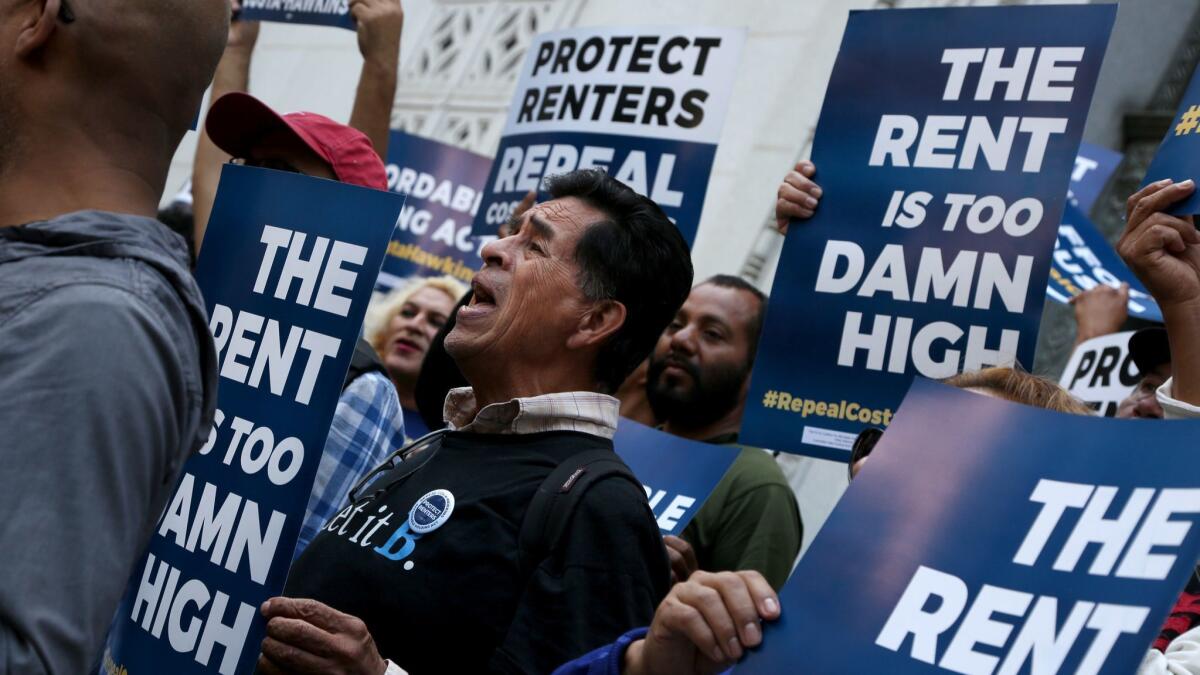How California has become a national battleground for rent control as money flows in from landlords

- Share via
Reporting from Sacramento — For some of California’s largest real estate investors, the fight over an initiative to expand rent control goes beyond the state’s borders. They’ve opened their wallets to prove it.
Eight of California’s top owners of apartment buildings and their related business entities have donated nearly half of the $74 million raised to defeat Proposition 10, according to a Los Angeles Times analysis of state campaign finance data.
Many of the landlords are publicly traded real estate investment companies with portfolios that span across the country. In earnings calls and investor conferences over the last year, company executives have spent significant time reassuring Wall Street they’re doing everything they can to defeat Proposition 10.
Their goal, the executives and market analysts say, is not just winning in California, but also preventing a wave of rent control measures that might follow nationwide. At this fall’s meeting of the National Multifamily Housing Council in Washington, D.C., organizers held a session on combating Proposition 10, which they called an “existential threat to the industry.”
“We’ll fight very hard at this level, and we will continue in every other place that talks about having rent control — we’ll fight at that level as well,” said David Neithercut, president and chief executive of Chicago-based Equity Residential, the country’s third-largest apartment owner, at an investor conference in September.
It’s expensive to be a tenant in California. Will Proposition 10’s rent control expansion help? »
Proposition 10 would repeal the Costa-Hawkins Rental Housing Act, a state law that prohibits cities and counties from imposing most new forms of rent control including on single-family homes or apartments built after 1995. If the initiative passes, local governments would be free to put any restrictions on rents that they choose.
Total fundraising for the ballot measure has topped $100 million, making it one of the most expensive campaigns in state history. Opponents have outraised supporters 3 to 1.
Historically, support for California ballot measures has declined as deep-pocketed opponents use their financial advantage to sow doubt about what an initiative might do. The Proposition 10 campaign is playing out the same way.
Voters like rent control and prefer it to other policies that aim to address the state’s housing affordability problems, according to polls this fall from the nonpartisan Public Policy Institute of California and USC Dornsife/Los Angeles Times.
But Proposition 10’s passage would leave crafting rent control measures up to local governments, making the ultimate outcome in each community unclear.
Opponents have seized on the uncertainty by arguing in advertisements that the initiative doesn’t provide immediate protection for renters. They also contend Californians who own single-family homes as investments would face the risk of new rent controls on their properties.
The PPIC’s September poll said that 38% of likely voters were in favor of Proposition 10. A PPIC poll a month later — conducted after opponents’ advertisements saturated airwaves — showed just 25% of likely voters said they would vote yes.
Proposition 10’s supporters have been unable to counter the onslaught of advertising against them. The campaign’s single largest donor is the Los Angeles nonprofit AIDS Healthcare Foundation, which has contributed $23.1 million — 94% of the money raised by proponents of the measure.
The organization, which operates a global network of clinics and pharmacies, has been a familiar name in recent state and local ballot initiative battles, bankrolling unsuccessful campaigns to lower prescription drug prices, mandate the use of condoms in adult film productions and slow growth in Los Angeles.
Michael Weinstein, president of the AIDS Healthcare Foundation, said he expected to be outspent by a large margin on Proposition 10, and criticized advertisements against the initiative as misleading, an opinion shared by others supporting the initiative.
“Here you have some of the largest corporate landlords in the country reaping huge profits from the housing crisis itself,” said Amy Schur, state campaign director for the nonprofit Alliance of Californians for Community Empowerment. “To turn around and run ads that are designed to confuse voters and purport to care about housing problems, it is such a disservice to voters who need to know the facts.”
The real estate companies fighting Proposition 10 say the initiative would make California’s housing affordability problems worse. In calls with market analysts, company executives have pointed to economic research showing that rent control doesn’t help with overall housing affordability, and said the state should instead work to boost the supply of housing while increasing subsidies.
San Mateo-based Essex Property Trust, the state’s second-largest landlord and the country’s sixth, has donated $150,000 to the campaign for Propositions 1 and 2, state bonds on the November ballot that would fund new housing for low-income and homeless residents.
But the companies have also said they’re against Proposition 10 because expanded rent control would hurt their bottom lines.
Michael Schall, president and chief executive of Essex, told analysts in August that the possibility of expanded rent control was a “critical consideration” in all the company’s investment decisions. Executives at other large real estate investors echo Schall’s worries about the effects on their business if Proposition 10 passes.
“It’s very hard to handicap what the impact will be on any company,” Neithercut told analysts in September. “It’s not good.”
Wall Street has been watching Proposition 10 closely, with Essex facing the most scrutiny.
The company owns 49,000 apartments in California, which represents more than 80% of its nationwide portfolio, according to real estate analysis company CoStar Group.
Earlier this year, Essex was underperforming compared with other publicly traded apartment owners by almost 10%, but its stock has rebounded as polls have shown Proposition 10 faring poorly, said John Pawlowski, a residential analyst at Newport Beach-based Green Street Advisors.
”Essex Property Trust inherently carries the greatest exposure to at-risk cities given its outsized California presence,” Pawlowski wrote in a July note to investors.
Essex and its founder George M. Marcus are the top contributors to the campaign against Proposition 10, donating a combined $9 million. The company itself has given $6.6 million, with the additional $2.4 million coming from a corporation affiliated with Marcus, who remains Essex’s board chairman.
Seven of the state’s other top landlords also are major donors. Contributions totaling $7.5 million have come from New York-based private equity firm Blackstone Group and Invitation Homes, a single-family rental company in which Blackstone is a major shareholder. Matt Anderson, a Blackstone spokesman, said in a statement that the company donated because it had “a responsibility as fiduciaries to protect their investors, which include retirement systems that pay benefits to millions of pensioners.” San Francisco’s public employee pension system, for instance, invested in a Blackstone real estate fund in 2015, as first reported by the Guardian.
Equity Residential, founded by former Los Angeles Times owner Sam Zell, has donated $5.2 million.
Invitation and Equity are facing federal class-action lawsuits from renters in California, each alleging excessive late fees. Both companies declined to comment on the litigation.
California’s largest landlord, the Irvine Co., which owns nearly 64,000 apartments in the state, has not contributed to the opposition campaign. But it has donated $4 million to the state Republican Party, which has spent roughly the same amount in advertisements to party members urging a vote against Proposition 10.
Major apartment owners are also thinking about other properties across the country as they spend against Proposition 10.
In the United States, rent control has expanded and contracted in waves. Soon after the country entered World War II, rent control policies were developed to discourage profiteering as people moved across the country for wartime jobs. The policies died out by the early 1950s following a massive housing production boom. Rent control expanded again in the 1970s in part because of rising inflation, then contracted in the 1990s when California and Massachusetts restricted its use.
The real estate investment companies fear the success of Proposition 10 could have the potential to start another wave of rent control, said Michael Lewis, an analyst who covers the industry for corporate and investment bank SunTrust Robinson Humphrey.
“It would be like, for example, having a new communist government overseas,” Lewis said. “The U.S. just doesn’t want to see it.”
Coverage of California politics »
More to Read
Get the L.A. Times Politics newsletter
Deeply reported insights into legislation, politics and policy from Sacramento, Washington and beyond. In your inbox twice per week.
You may occasionally receive promotional content from the Los Angeles Times.











